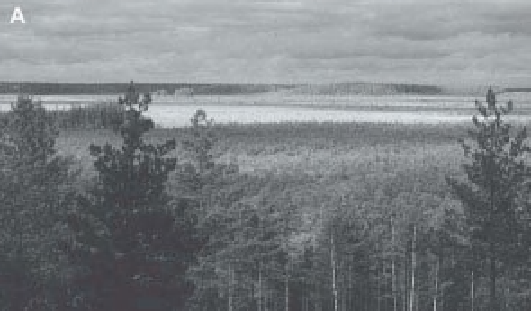Geoscience Reference
In-Depth Information
Figure 8-6.
Meenikunno, a large bog complex south of Tartu, Estonia. Meenikunno is a mature, raised bog that
encompasses several lakes and mineral islands (stage 5). A. Overview toward the center of the bog, which is a
nearly treeless plateau (light zone in middle distance). B. Dwarf pine trees, grass, and moss cover in the southern
portion of the bog. Notice the wooden board path to right. Photos by J.S. Aber.
∼
2. Sangamon sea level, peak
130,000 years
ago.
3. High sea level with peak
∼
180,000 years ago.
∼
4. High sea level with peak
236,000 years ago.
∼
5. High sea level with peak
324,000 years ago.
6. Earliest preserved high sea level, age
uncertain.
The highest sea level achieved during any of
these cycles was by the Sangamon (Eemian) Sea
(Fig. 8-7). Sea level stood 5-8 m higher than at
present; all of southern Florida was submerged,
and the shoreline was located approximately
250 km (150 miles) farther north across the
Florida peninsula. In many other parts of the
world, the Sangamon Sea is marked by marine
deposits or erosional beach terraces a few
meters above present sea level (Fig. 8-8). In the
Bahamas, sea level stood about 2 m above
present during the time interval 132,000 to
118,000 years ago. Near the end of this period,
sea level rose rapidly to
Figure 8-7.
Miami Oolite, the limestone formation that
underlies much of Miami, Florida. The limestone was
deposited as carbonate sand on a shallow marine bank,
much like the modern Bahama Bank. The Miami Oolite
is a northern continuation of the Key Largo Limestone
trend; they were deposited simultaneously during high
sea level
∼
125,000 years ago (Enos and Perkins 1977).
Photo by J.S. Aber.
+
6 m; this highest stand
of sea level was quite brief, lasting perhaps
only a few centuries before declining rapidly
(Neumann and Hearty 1996). The mechanism
for such a large and rapid change in sea level
is thought to be related to possible ice-sheet
surging into the ocean.
Until recently, the Sangamon sea level was
considered to be the highest of the Pleistocene.
However, sea level may have stood even higher
about 420,000 to 400,000 years ago (Hearty
et al. 1999; Poore and Dowsett 2001). Sea level
may have exceeded 20 m above present in the
Caribbean Sea, Bahamas and Bermuda, which
implies that both the Greenland and West Ant-
arctic ice sheets were absent or greatly reduced.
Considering the modern concerns for sea-level
rise, it is wise to keep in mind the magnitudes
and rates of entirely natural eustatic sea-level







